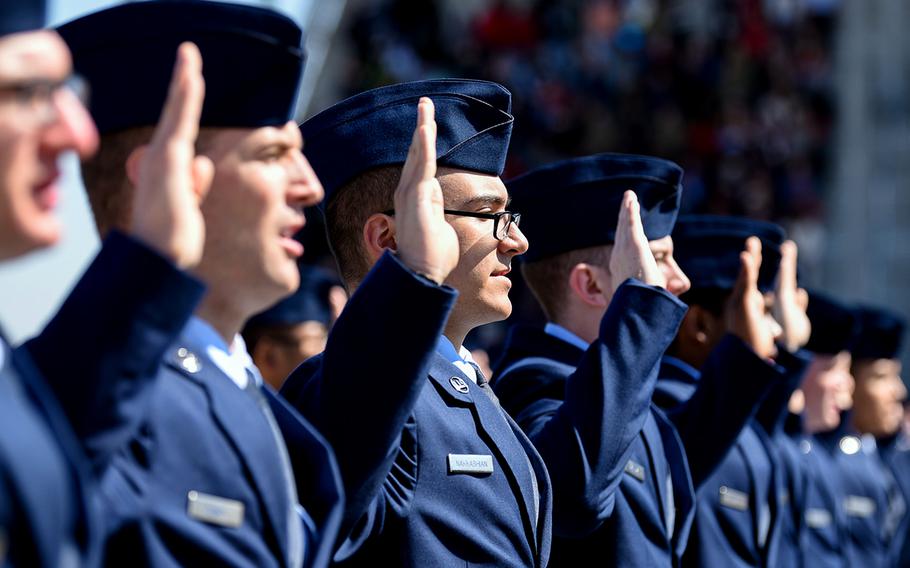
More than 700 airmen and Guardians assigned to the 320 Training Squadron graduated March 10, 2022, from basic training at Lackland Air Force Base, Texas. Maj. Gen. Ed Thomas, the head of of the service’s recruitment command, says the Air Force is facing its biggest recruiting challenge in decades. (Miriam Thurber/U.S. Air Force)
STUTTGART, Germany — The U.S. Air Force will struggle to hit its recruiting goal this year as it confronts the toughest hiring environment in nearly a generation, the two-star general in charge of its efforts to enlist new members told Stars and Stripes.
And the long-term trends appear equally ominous, Maj. Gen. Ed Thomas said Thursday during a stop at a U.S. military base in Stuttgart.
Thomas, who is in Europe to meet with recruiters and other military officials at bases in Germany, Italy and the United Kingdom, said the push is now on to make up lost ground.
“The theme right now for us, from Tokyo to Aviano, is presence, presence, presence,” said Thomas, commander of the U.S. Air Force Recruiting Service. “No teleworking. We need to be in offices, schools, public spaces. Our message: We are hiring.”
Thomas first raised the recruitment alarm in a January memo to his staff that said “we have warning lights flashing.” For example, the number of possible recruits classified on a “qualified and waiting” list was about half of what it has historically been, Thomas wrote.
Now, the Air Force, like the other services, is grappling with a math problem, he said.
The Air Force recruitment goal is 27,452 new airmen by Sept. 30. Halfway into the fiscal year, 9,920 new recruits are in uniform and 5,314 have signed contracts, according to Air Force data.
“We will struggle to meet our recruiting goal for fiscal year 2022,” Thomas said. “This is really the hardest recruiting environment since about 1999.”
For starters, there is an overall labor shortage in the U.S., where unemployment rates are at historic lows and the military is in a battle for talent with the civilian sector, Thomas said.
Then there is the aggregate effect of recruiters largely being absent for two years from schools, county fairs and other public meeting places because of the coronavirus pandemic, he said.
Studies show that there is no replacement for face-to-face meetings with potential recruits, Thomas said.
Also, research indicates that fewer young Americans have an interest in military careers, and the number has dropped sharply during the pandemic, he said.
The lack of interest in military service is part of a broader cultural disconnect between the military and the civilian world that will pose long-term recruiting challenges, Thomas said.
Then factor in that roughly 75% of young Americans don’t qualify to begin with because of a growing obesity problem and other health and medical issues, and the squeeze is on, he added.
”That is staggering,” Thomas said. “That is a very troubling statistic, not just for us but for America.”
Assuming public life is set to soon return to more of a post-pandemic normal, Thomas expects a numbers bump because recruiters will be back in force in the public square. Still, any boost could be short-lived.
“We are pedaling uphill into headwinds,” he said. “We think this is longer-term because the math problem doesn’t go away.”
One bright spot is the overseas military community, where Air Force recruiters are on target to meet all their goals, Thomas said.
“The European theater, it is family business when it comes to recruiting. The advantages we do have here is the kids have exposure to the military,” he said. “So we are depending on the military family to come and serve.”
But even that is a “double-edged sword,” Thomas said, because it reinforces a civilian and military divide among the U.S. population and does little to solve the underlying problem of reaching Americans with no family military connection.